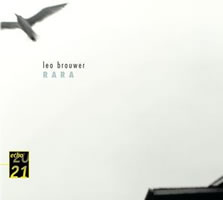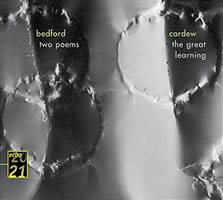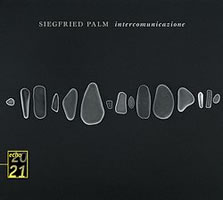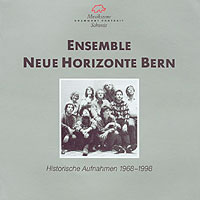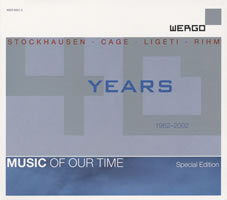Up from the Archives
|
Grant Chu Covell [March 2003.] Deutsche Grammophon’s Echo 20/21 series Finally Deutsche Grammophon plumbs its archives! The Echo 20/21 series reissues items that have slid out of print, and is the companion line to DGs acclaimed 20/21 series featuring fresh recordings of new music. Even with their hip graphics and repackaging — maybe they saw a Budapest Music Center Records product and went “Aha!” — these are no-nonsense productions. A short, multilingual page brings each disc up to date, but some oddities, perhaps mistakes, carry over, a sampling of which I point out below. I earnestly hope DG keeps them coming, including some of the Ferrari and Kagel in their vaults. Here’s a look at four of the reissues.
Leo Brouwer: RARA. Cornelius CARDEW: Material (1960); Hans Werner HENZE: Memories from Cimarrón (1969-70); Leo BROUWER: Exaedros I (1969); La espiral eternal (1971); Sylvano BUSSOTTI: Rara (eco sierologico) (1967); Maurice OHANA: Si le jour paraît (1971); Josep Maria MESTRES QUADRENY: Perludi para guitarra (1968); Girolamo ARRIGO: Serenata per chitarra (1961); Cristóbal HALFFTER: Codex I (1963); Juan BLANCO: Contrapunto Espacial III-c (1969); Leo Brouwer, guitar. DG 471 589-2 (http://www.deutschegrammophon.com/20-21/). Originally released in 1971 and 1973. DG assembled recordings from 1970 and 1972 for this reissue featuring guitarist Leo Brouwer. Most of the pieces were written in the decade just before the recordings were made, and some composers are relatively unknown. Listeners are largely on their own with respect to hardcore contemporary compositions, as only a few receive treatment in the notes. For example, we do not learn that Juan Blanco went on to become a key proponent of electroacoustic music in Cuba, or that his work for guitar is related to a controversial large-scale, experimental stage work involving musicians and actors whose actions progressed from fetal to lovemaking positions. But thankfully there’s Google, and after a bit of trawling, we learn that Josep Maria Mestres Quadreny wrote some of his music with the help of a computer while the audience determined other aspects. Both Blanco’s and Mestres Quadreny’s pieces are short and frisky. Mestres Quadreny asks for most of Perludi to be played on less frequently used parts of the fingerboard. Another Google search tells us that Ohana’s Si le jour paraît is actually a seven-movement, 23-minute work for solo guitar. It seems that Brouwer is playing just one of the movements. Henze is one of the more familiar names, and Brouwer has extracted several movements from his song cycle Cimarrón. The most avant-garde sounds are contained in this track: Brouwer uses a cello bow and what sounds like a glass bottle on the fingerboard. It’s the longest piece here (15:22) and it doesn’t move me as much as Bussotti’s Rara, a wild exploration of everything a guitar and guitarist can do, or Brouwer’s own compositions, such as the Ligeti-like La espiral eternal — think Continuum (see below!). Some works are multi-tracked recordings and it is not clear whether Brouwer played against a tape of himself, or whether separate recordings were melded in the studio. Cardew’s brief Material is one such piece and it sounds like two simultaneous passes through the same colorful collections of chords. Brouwer’s Exaedros I and Blanco’s Contrapunto Espacial III-c are also multi-tracked recordings, though Brouwer’s virtuosity could be fooling me in the Blanco. Brouwer’s stunning technique downplays the dissonance of the most severe pieces. He is a wonderful guitarist to listen to. It’s astounding how a note gently vibrates or subtly changes pitch as it fades away. If you don’t know him, then you should. (Naxos is working on a series of his guitar pieces.) This isn’t easy listening, but it is rewarding.
Cornelius CARDEW: Paragraph 2 (1969) and Paragraph 7 (1969) of The Great Learning; David BEDFORD: Two Poems for Chorus on Words of Kenneth Patchen (1966). The Scratch Orchestra, Cornelius Cardew (cond.); Chor des Norddeutschen Rundfunks Hamburg, Helmut Franz (cond.). DG 471 572-2 (http://www.deutschegrammophon.com/20-21/). Originally recorded and released in 1968 (Bedford) and 1971 (Cardew). It is good to see Cardew’s music back in the active catalog, not just little pieces like Material on Brouwer’s guitar program, but also substantial works, like these two sections from the ambitious The Great Learning. The Great Learning is the classic Confucian text. Its first chapter consists of seven paragraphs from each of which Cardew derived a musical work. Ideally, a complete performance of The Great Learning would take several hours. These performances of Paragraph 2 and Paragraph 7 were designed to fit on a single side of an LP. The performances are by The Scratch Orchestra, the celebrated ragtag of professional and amateur musicians, teachers, and composers (Gavin Byars, Brian Eno, Howard Skempton, John Tilbury, et al.) who came together to play The Great Learning. Cardew’s training was with the best and brightest of the postwar era. He had worked with Stockhausen on Carré and then drank up Cage’s aesthetic. But he became uneasy when he realized that contemporary music had little to do with everyday life. Consequently, he began to create music that anybody could play, and gradually adopted an explicitly Communist outlook. The Great Learning’s Paragraph 2 is for drummers and singing voices. It’s primitive and shocking in its simplicity. From the start, the voices are nearly drowned by the chaos of drums (sounding almost like dozens of basketballs being dribbled all at once) and as the piece progresses, the voices die away and the drums synchronize. Paragraph 7 is for singing voices and starts as a single dense chord. It too is primal and unexpected. But deserving of a historic re-release? Yes, most definitely. Realize that Cardew’s ideas were incendiary in 1970’s England. In 1981, he was killed by a hit-and-run driver, and even today some folks think he was murdered. David Bedford is a less confrontational revolutionary. He studied with Lennox Berkeley and Nono (what a combo!), and some of his music is meant to be played by children: An Exciting New Game for Children of All Ages (1969). He’s also written music for 100 kazoos (With 100 Kazoos of 1971) and music for drums, bell bars and milk bottles (Whitefield Music 1 of 1967). Other titles I can’t resist mentioning are 18 Bricks left on April 21st (1967), for three electric guitars, and Pancakes, with Butter, Maple Syrup and Bacon and the TV Weatherman (1973), for brass quintet. But in these Two Poems from 1966 we can hear that Bedford absorbed some of Nono’s intensity and continual desire to search out meaningful modes of expression. Bedford is immensely fond of Kenneth Patchen, whose poetry he has set almost exclusively. These two poems are not strict settings, indulging rather in word painting, vocal effects, and all the tricks of contemporary choral writing. The Chor des Norddeutschen Rundfunks Hamburg under Helmut Franz is especially cool and crisp. I wonder why this or other of Bedford’s settings aren’t in that monstrous Schola Cantorum set on Bayer (Bayer CAD 800 901).
Luciano BERIO: Coro (1975 / 76, 1977). Kölner Rundfunkchor, Kölner Rundfunk-Sinfonie-Orchester, Luciano Berio, conducting. DG 471 587-2 (http://www.deutschegrammophon.com/20-21/). Recorded in 1979 and originally released in 1980. What to do about Berio? I confess that his music generates alternating feelings of ambivalence and fascination. A handful of works such as Visage (1961), Sinfonia (1968-69), and the series of Sequenzas (begun in 1958, the most recent was completed in 1995) have cemented his importance to the music of the 20th century. However, some of his arrangements and reworkings of the music of others are puzzling, such as Renderings (1989), his take on Schubert’s 10th Symphony, where I suspect Berio is fussing with inessentials instead of tackling big, important projects. Coro reminds us that Berio is one of the best. Written for 40 singers and 44 instrumentalists, the work’s 31 songs are presented in an unbroken and layered sequence. Each song is set for varying forces although voice and instrument pairs are emphasized right down to the seating plan. Texts range from folk songs to despairing poems by Pablo Neruda. The work opens with the classic combination of voice and piano, but other voices and instruments soon enter and we are treated to a wide array of song types and styles. It’s a wily and imaginative piece, and one of the few works for chorus and instruments that reminds us that the chorus is essentially a crowd coming together to deliver a message. The booklet reprints Berio’s original notes from 1980 and one paragraph reflects Berio’s friendship and affinity with Umberto Eco, author of The Open Work, and Italo Calvino, author of the literary sources for several of Berio’s operas: “Coro is therefore also an anthology of different modes of ‘setting to music,’ hence to be listened to as an ‘open project,’ in the sense that it could continue to generate ever different situations and relations. It is like the plan for an imaginary city which is realized on different levels, which produces, assembles and unifies different things and persons, reveling their collective and individual characters, their distance, their relationships and conflicts within real and ideal borders.” Savoring this reissue, I’m surprised to recognize bits of Sequenza VIII, the solo violin Sequenza of 1976, in track nine under the setting of the Navaho Indian song “It is so nice.”
Siegfried Palm: Intercomunicazione. Anton WEBERN: Sonata for cello and piano (1914), Drei kleine Stücke, Op. 11 (1914); Iannis XENAKIS: Nomos alpha (1965); Mauricio KAGEL: Unguis incarnatus est (1972); Bernd Alois ZIMMERMANN: Vier kurze Studien (1970); Intercomunicazione (1967); Krzysztof PENDERECKI: Capriccio per Siegfried Palm (1968); Earle BROWN: Music for Cello and Piano (1955); Isang YUN: Glissées (1970). Siegfried Palm, cello. Aloys Kontarsky, piano. DG 471 573-2 (http://www.deutschegrammophon.com/20-21/). Originally recorded in 1969 (Zimmermann only) and 1974, and released in 1969 (Zimmermann only) and 1975. This is a great disc, a mesmerizing kaleidoscope of contemporary trends. Most of the works here were either written for or premiered by cellist Siegfried Palm. The performance of Zimmermann’s Intercomunicazione for cello and piano is worth the price alone. Or you could get this just to hear Palm play Webern or tear through the Xenakis. In Unguis incarnatus est for cello and piano, we get a typically theatrical Kagel work that uses Liszt as its starting point to confront musical history. Notes from Nuages gris are overwhelmed by a repetitive stomping of the piano pedals. The pedal pounding eventually overwhelms everything else and the work ends in the players loudly shouting out Liszt’s name forwards and backwards (“tzsil” sounds like “Ziel,” which is “end” in German). The Brown is a graphic work, and Palm and Kontarsky pull out all the stops. But texture and ideology aside, this one lacks the interesting colors and meaningful arrangements of pitches found in the other works (a fact that many graphic composers eventually realized, hence the late, fully notated and wonderful works of Feldman and Cage). Penderecki’s brief Capriccio for cello solo unleashes complexity and dissonance before coming to rest on a major chord. Yun’s Glissées also for solo cello concentrates on glissandos, and extended sections are entirely pizzicato. Zimmermann’s Intercomunicazione is the longest work. Bleak and barren, its tentatively established pulse gradually grows stronger but slower. The title is ironic as the more the cello and piano try to interact meaningfully, the slower and more inert the music becomes. By comparison, both Webern works, especially the two-minute Sonata for cello and piano, are short and bright like a streetlight illuminating falling snowflakes. Problems, however, with the Xenakis: The date given here for the solo cello work Nomos alpha is 1965, whereas the date in Xenakis’ catalog is actually 1966. Quick comparison with takes by Rohan de Saram (Montaigne MO 782137) and Pierre Strauch (Erato 2292 45770-2), and a scan of the first measures as they appear in Xenakis’ Formalized Music reveal that Palm starts the work at the end of measure three. Did DG simply repeat a recording error, or is this an early version? Still, it is a breathtaking performance. Saram and Strauch offer greater precision in tempo and intonation, especially Saram, but neither matches Palm’s vigor. The big surprise remains with the music: Nomos alpha closes with an astounding tour-de-force of two simultaneous scales in contrary motion with different dynamics and tempos spanning the entire range of the instrument. Ensemble Neue Horizonte Bern: Historische Aufnahmen, 1968-1998
Earle BROWN: December from Folio (1952); Matthias BRUPPACHER: two fragments from Mathias Brupacher (1992); John CAGE: Variations 2 (1961); excerpt from Song Books (1970); Cornelius CARDEW: one single page from Treatise (1967); Tzie M. ELGNA: Ähre (1988); Franco EVANGELISTI: Proporzioni (1958); Morton FELDMAN: Durations 2 (1960); Jürg FREY: two versions of Lachen und Lächeln (1978); Part 6 of Sachen (1980); Karel GOEYVAERTS: excerpt from Zum Kern hin (1969); Hans Joachim HESPOS: Anregung –Z (1969); Rudolf KOMOROUS: Die süsse Königen (1964); Pierre MARIÉTAN: Matriochka from Initiatives (1968); MF-MP Communication instrumentale et radiophonique (1970); Philippe MICOL: Dritte Studie zur Metrik (1993); Roland MOSER: Abhängigkeiten (1968/72); Weltlauf from Heinelieder (1978); Eduardo POLONIO: excerpt from AI (1971); Henri POUSSEUR: Devise suivi d’Icare apprenti (1970); Erika RADERMACHER: Leuchten from Sieben Rosen später (1981); Musenkonzept (1990); Frederic RZEWSKI: Now or Never (1976/81); two fragments from Composition for Two Players (1964); Urs Peter SCHNEIDER: Raritäten für Interpreten (1959/71); Wald from Mit Dank an Mendelssohn (1981); Peter STREIFF: Sechs Partikel (1970/72); Hansjürgen WÄLDELE: W für Fünf (1992); Christian WOLFF: Duo for Pianists 1 (1957); Play from Prose Collection (1968); La Monte YOUNG: two versions of Composition 7 (1960); Istvàn ZELENKA: Die Reintöchter sind hier gänzlich verschwunden (1971). Ensemble Neue Horizonte Bern: Matthias Bruppacher, Suzanne Huber, Elisabeth Grimm, Roland Moser, Erika Radermacher, Urs Peter Schneider, Niklaus Sitter, Peter Streiff, Hansjürgen Wäldele, et al. Musikszene Schweiz MGB CTS-M 76 (http://www.musikszene-schweiz.ch/). Distributed in the US by Qualiton (http://www.qualiton.com/). This is a wonderful and quirky two-CD set. Twenty-four composers are represented by 36 tracks, 18 on each disc. The works are sequenced in alphabetic order. Some tracks are excerpts, but most are complete movements, and some works appear in two versions. Several composers appear on both discs, or have two works in succession. The notes explain: “The whole is ordered as a ‘composed out’ programme, in which the individual works relate to each other in numerous ways, complement each other, comment on each other, alongside each other, opposite each other, for each other. The programme here comprises mostly works notated in the form of playing concepts, playing instructions and improvisatory materials, through they are contrasted with music that is notated conventionally throughout.” The Ensemble Neue Horizonte Bern gave its first concert on April 24, 1968, playing Brown, Cage, Feldman and Wolff. They have concentrated on the more avant-garde, improvisatory, and aleatoric works of the past 35 years, often presenting the first Swiss premieres if not world premieres of many works. The booklet is just as quirky as the program: Every other paragraph lists an assortment of composers or performance locations. Oddly, only the current members of the ensemble are listed. There are a handful of mandatory composers: Cage is represented by Variations 2 and an exceptionally chaotic performance of Song Books. Feldman’s Durations 2 is a calm oasis among more frenetic works by Goeyvaerts and Radermacher. A bit of Brown’s important but rarely done Folio is here, as are contemporaneous works by Wolff. Young is not as well represented in recordings as he should be, and we get two versions (0:21 and 0:33) of the diminutive Composition 7. A revelatory discovery is Pierre Mariétan (b. 1935). The intensity and colorful juxtapositions of his MF-MP Communication instrumentale et radiophonique made me think of the contemporaneous and coy works of Luc Ferrari. Matriochka from Initiatives is just as vigorous and clever. It opens with several disjointed actions repeating but gradually changing: a shout turns into a sigh, a fluttery burst from a slide whistle, a piano cluster, some saltando notes from a violin, and something metallic clattering to the floor. I’m trying to get my hands on other recordings of Mariétan, so watch this space. Folks who own any of col legno’s discs ought to get this too. What the Ensemble Neue Horizonte Bern does is vastly different from what might happen at the Donaueschinger Musiktage (well, this may be less true today), but the relevance to 20th century music is just as important. Wergo at 40
WERGO 40 YEARS (1962-2002): Special Edition. WER 6921-2 (http://www.wergo.de/). Distributed in the US by Harmonia Mundi (http://www.harmoniamundi.com/HMboutique/). CD 1: Karlheinz STOCKHAUSEN: Kontakte (1959-60). David Tudor, piano and percussion; Christoph Caskel, percussion; Karlheinz Stockhausen, Gottfried Michael Koenig, electronics. Originally released in 1964 as WER 6009-2. CD 2: John CAGE: Roaratorio (1979), Writing for the Second Time Through Finnegans Wake (1979, excerpt). John Cage, Joe Heaney, voices; Paddy Glackin, violin; Peadar Mercier, Mel Mercier, bodrhan; Mat Malloy, flute; Seamus Ennis, uillean-pipes; Klaus Schöning, editor. Originally released in 1994 as WER 6303-2. CD 3: György LIGETI: Trio for Horn, Violin and Piano (1982); Passacaglia ungarese (1978); Hungarian Rock (1978); Continuum (1968); Three Pieces for Two Pianos (1976). Saschko Gawriloff, violin; Hermann Baumann; horn; Eckart Besch, piano. Elisabeth Chojnacka, harpsichord; Antonio Ballista, Bruno Canino, pianos. Originally released in 1986 as WER 60100-50. CD 4: Wolfgang RIHM: Kolchis (1992), Antlitz (1993); Klavierstück No. 6, “Bagatellen” (1977-8); von weit (1993); Dritte Musik (1993). Ensemble Recherche: Melise Mellinger, violin; Lucas Fels, cello; Klaus Steffes-Holländer, piano; Christian Dierstein, percussion. Sarah O’Brien, harp; Frank Reinecke, bass. Gottfried Schneider, violin; SWF-Sinfonieorchester, Michael Gielen, conducting. Originally released in 1997 as WER 6623-2. For its 40th birthday, Wergo has repackaged four representative CDs in an attractive and affordable box. Each disc features a single composer: Stockhausen, Cage, Ligeti and Rihm. It’s hard to imagine that the serious fan of 20th century music will not already have some of these, but Wergo has released so much that is good and essential that it’s possible that this set will not duplicate. The discs themselves have new silk-screening, and the tray has new graphics and formatting, but the actual booklets seem to be the same as the original release. Considering that the Stockhausen disc at 35:05 is ordinarily priced as a full-length import, this set is a very tempting offering. Kontakte is one of Stockhausen’s most important works. Even though the electronics sound a bit campy by today’s standards, what Stockhausen (and Koenig) did with the time and means at their disposal is miraculous. Kontakte exists in two versions, one for tape alone, and the other for tape with piano and percussion. The version for tape and instruments premièred June 11, 1960, and that is the version recorded here. Kontakte is written in the guise of what Stockhausen called “moment form.” Setting aside all forms and traditions that have gone before, “moment form” is music where each sound exists only in its moment. There are no relationships, none of the customary development of material, and to some extent, no beginning and ending. Kontakte is in two parts, the first with heavier and darker sounds, the second lighter and more ethereal. Other performances of Kontakte are out there, but this is the one to know. Cage’s Roaratorio is one of his best compositions; it earned him the Karl Sczuka Prize at Donaueschingen. It is also one of the best examples of hörspiel, that genre of music ideal for radio performance, as it’s meant to be listened to without visual stimulation, permitting the imagination to run wild. Cage said that “ the purpose of music (and I trust of hörspiel too) is to sober and quiet the mind thus making it susceptible to divine influences.” “Roaratorio” is a word plucked from Joyce’s Finnegans Wake, and this piece is a 60-minute joyous romp through Joyce’s great opus. Much like Finnegans Wake itself, the work consists of just about everything, jumbled, barely recognizable and on the verge of something entirely new. Sounds mentioned in Finnegans Wake were recorded from all over the world — especially Ireland — and mixed. As the collage unfolds, Cage reads Writing for the Second Time Through Finnegans Wake, his own poetical text derived from Joyce’s. There is also a circus of traditional Irish musicians whose playing weaves through the collage and Cage’s speech. Wergo, Sony and Teldec have all taken shots at releasing collections of Ligeti’s music. Wergo’s offerings predate the Sony and Teldec series, and their catalog has much of Ligeti’s work from the 1960s and 70s, including the only available recordings of the tape pieces Artikulation and Glissandi (WER 60161-050). DG’s Echo 20/21 series also has a Ligeti disc (DG 471 608-2) which contains the organ works Volumnia and Harmonies played by Gerd Zacher, the extroverted theatre pieces Aventures and Nouvelles Aventures, the Kontarsky brothers in Three Pieces for Two Pianos, and arias extracted from the opera Le Grand Macabre and arranged by Elgar Howarth for trumpet and piano. This Ligeti re-release focuses on chamber and solo pieces written between 1968 and 1982. I remember a time when the earliest piece here, and still fascinating, Continuum, for harpsichord, seemed daring. A minimal work performed at breakneck speed, Continuum starts with a dense cluster of notes played in sequence over and over. Gradually new notes are added and some are removed. It’s a surefire way to get tendonitis — how does Chojnacka do it? The other two harpsichord works, Passacaglia ungarese and Hungarian Rock, are less demanding and bring folk tunes to complex and insistent rhythmic patterns. The bewitching Horn Trio of 1982 begins the Ligeti disc. Subtle microtonal notes from the horn add color to the fixed pitches of the piano, and the fast movements contain the difficult and fast-moving rhythmic patterns of Bartók and Ligeti’s own piano etudes. This is one of Ligeti’s most satisfying works, and one of his most classical, looking back to Brahms’ own Horn Trio and further back to Beethoven (the opening gesture of the trio spoofs Beethoven’s Les Adiuex Piano Sonata). The disc of Rihm’s music collects several of the works that arose from the composer’s friendship with the visual artist Kurt Kocherscheidt (1943-1992). Kolchis, a short and colorful burst for harp, piano, percussion, cello and bass, and Dritte Musik, a dark and melancholy piece for violin and orchestra (Anne-Sophie Mutter should have paired this with the Berg concerto instead of Rihm’s Gesungene Zeit on DG 437 093-2!), are both dedicated to Kocherscheidt. Klavierstück No. 6 for piano which contrasts traditional harmonies and abstract gestures was written as a thank-you for a drawing that the artist had made for Rihm, and a reproduction of this and other art appears in the booklet. These works are more delicate and spacious than some of Rihm’s most recently recorded music such as the lush and almost baroque Jagden und Formen, a deep reworking of several other orchestral compositions (the Ensemble Modern is ably conducted by Dominique My on Deutsche Grammophon 471 558-2). As I’ve said before, I’ve listened to Rihm quite earnestly and have had trouble getting into it, but this disc stands repeated hearings. The key thing here is the delicacy of the performances, especially those of von weit, for cello and piano, and Antlitz, for violin and piano. In both pieces slow-moving lines and gestures are contrasted with loud outbursts that make the piano ring and resonate. How did Wergo choose what to include and what to leave out? Lots of fine performers appear in this collection, David Tudor, Elisabeth Chojnacka, and Michael Gielen among them. But it’s odd not to see any of the Kontarskys or Herbert Henck. I imagine that a fifth disc would have to be devoted to Henze and a sixth would contain excerpts from the Computer Music Series. Wergo has done well in its first forty years. Here’s to at least forty more!
Arrigo, BA Zimmermann, Bedford, Berio, Blanco, Brouwer, Brown, Bussotti, C Halffter, Cage, Cardew, Henze, Kagel, Ligeti, Ohana, Penderecki, Rihm, Stockhausen, Webern, Xenakis, Yun
[More Grant Chu Covell]
[More
Arrigo, BA Zimmermann, Bedford, Berio, Blanco, Brouwer, Brown, Bussotti, C Halffter, Cage, Cardew, Henze, Kagel, Ligeti, Ohana, Penderecki, Rihm, Stockhausen, Webern, Xenakis, Yun]
[Previous Article:
New Goldbergs and Old Gouldbergs]
[Next Article:
Göteborgs Wond’rous Machine]
|
